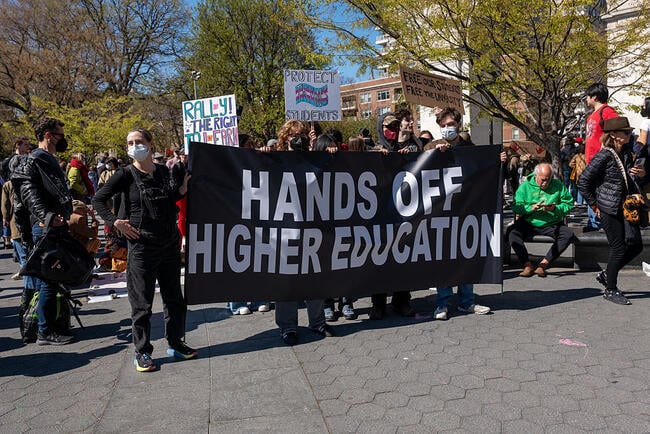You have /5 articles left.
Sign up for a free account or log in.

New York protesters rally in support of higher education and in opposition to student deportations and federal funding cuts to universities on April 17.
Spencer Platt/Getty Images News
Amid federal funding cuts and freezes, broad anti-DEI directives and sweeping antisemitism investigations, colleges and universities have put up little resistance to President Trump’s multipronged onslaught on higher ed—until now.
What started as a trickle of campus leaders speaking out against the Trump administration has gathered force after the Joint Task Force to Combat Anti-Semitism hit Harvard University with a detailed list of demands that called for major changes to its admissions process, audits of academic programs and a review of the ideological composition of its faculty and students. Harvard promptly refused to comply and sued the administration, which claimed the demand letter was sent in error but nonetheless stood by it.
Since then, a group of more than 500 higher ed leaders signed a statement, released by the American Association of Colleges and Universities, opposing “undue government intrusion in the lives of those who learn, live, and work on our campuses.” Presidents of highly selective universities, threatened by some of the most severe federal funding cuts, have reportedly developed a network to agree on shared boundaries and talk strategy. And faculty members at the Big Ten universities are ramping up pressure on their institutions to collaborate and defend one another against threats from the administration.
Jon Fansmith, senior vice president of government relations and national engagement at the American Council on Education, said the letter to Harvard was a “turning point.”
The demands made it “crystal clear” that “the administration’s end goals here have nothing to do with addressing antisemitism or sustaining a partnership” with institutions, Fansmith said. “It’s about wholly taking over the institutions and dictating what academic life looks like at these colleges and universities. For a lot of people, I think that was probably pretty chilling, but at the same time, pretty galvanizing. This is not something that we can ever accept.”
Who’s Fighting Back
Colleges are increasingly starting to form and grow networks to support one another, take collective stands on federal policy and prepare for any further upheavals from the Trump administration.
Roughly 10 highly selective colleges and universities, including the Ivies and some top private research institutions, have formed a collective to resist the Trump administration’s interference into research funding and academic freedom, The Wall Street Journal reported. The group, which includes trustees and presidents, discusses how to respond to different kinds of federal demands, what changes—if any—they’re willing to make during negotiations and what lines the group is unwilling to cross, like giving up control over admissions, hiring or curriculum, according to the Journal. The goal is to avoid any member of the group setting a precedent that could harm the institutions over all.
“There’s always been networking and collaboration and asking for advice and sharing views and expertise,” Fansmith said. “It only makes sense there would be more of that when the threats are so much more pronounced and so much more significant and so much more immediate.”
A source familiar with the Trump administration told the Journal that federal officials have been worried about the possibility of collective resistance and sought to discourage at least one higher ed institution from collaborating with others.
Fansmith believes the Trump administration is right to worry, because when institutions communicate with one another, they’re a “stronger opponent.”
“It’s easier to knock down one at a time than a unified group,” Fansmith said.
Campus and academic society leaders also made a gesture of unity when more than 500 signed on to a “call for constructive engagement” from the American Association of Colleges and Universities. The statement marked the first time college presidents collectively spoke out about the political moment, according to the association.
“As leaders of America’s colleges, universities, and scholarly societies, we speak with one voice against the unprecedented government overreach and political interference now endangering American higher education,” the statement read.
Some faculty senates in the Big Ten Academic Alliance, a long-standing academic collaboration among institutions in the athletic conference, similarly signed on to a statement outlining “shared values of higher education,” stressing the negative effects of cuts to research funding. And some of those senates have gone a step further, calling on Big Ten institutions to adopt a “mutual academic defense compact”—a shared fund, or joint legal services—to support any of their institutions facing political attacks.
The Rutgers University Senate was the first to propose and pass a NATO-like defense compact among the institutions in a resolution in March. Since then, faculty or university senates at half of the 18 Big Ten institutions have done the same, including at Indiana University Bloomington, Michigan State University, the University of Michigan, the University of Nebraska, the University of Washington, Ohio State University, the University of Maryland and the University of Minnesota.
Paul Boxer, a professor of psychology at Rutgers, said he didn’t expect the idea of a defense compact to spread the way it did.
“It just really struck this chord with people in higher ed who thought, ‘Finally, someone’s taking steps to get everyone together for something collective,’” he said. He noted that Rutgers is among the universities under investigation for alleged antisemitism and civil rights violations, so “there doesn’t seem to be much point in waiting around to see if we get attacked in some way. And even if we do, we would much rather try not to go it alone.”
But faculty senates don’t actually have the power to make such a compact; they can only deliver their resolutions to campus leaders and hope that administrators decide to implement the plan, which they have yet to do.
“The Big Ten Academic Alliance did not contribute to and has not endorsed the Rutgers University Senate’s recent resolution, or similar resolutions from other universities, calling for a ‘mutual defense compact’ across Big Ten Academic Alliance universities,” a statement from the Big Ten Academic Alliance read. “None of the Big Ten Academic Alliance’s Board of Directors, its elected Officers, or its staff were involved in, contributed to, or were consulted about, the creation, formulation, or passage of any of the recent resolutions.”
Steven “Jim” Sherman, a psychology professor emeritus at Indiana University who spearheaded a resolution at his university modeled after Rutgers’s, said he isn’t worried by administrators’ reticence.
“The important thing was that university faculty are now standing together, now sharing their experiences, their threats, the way they solve problems,” he said. “That, to me, is at least as critical as having administrators jump on board and come up with financial support and legal support … I think that, sooner or later, it will happen.”
A New Moment
Boxer said it feels like “there aren’t many alternatives at this point” to efforts like a mutual defense compact. He said it seemed like the logical next step after watching the Trump administration hit Columbia University and then Harvard with harsh demands, slash federal research grants and launch numerous investigations.
“Grants are already being cut … What we’re trying to say to our administrators, and all these other administrators, is just, ‘Let’s get together and form this blockade to be ready in case any one of us is singled out,’” he said. “We know that we can all come together and push back.”
Sherman said Harvard’s defiance of the Trump administration was also a breaking point for higher ed and motivated more leaders and professors to take a public stand.
Many previously felt that the administration was only going after the “big dogs,” thinking, “Maybe if we just keep quiet and don’t make waves, they’ll leave us alone and ignore us,” he said. “I don’t think that’s possible anymore. I think once one of those big dogs stood up, it just makes it easier for other universities to act similarly.”
Todd Wolfson, president of the American Association of University Professors, believes administrators have been emboldened to join the fight after watching faculty, staff and students file lawsuits against the Trump administration, which are beginning to pay off.
He said administrators have been in a difficult position because “their first priority has to be to their individual institution, not to higher education writ large,” so some initially took a protective stance and tried to negotiate with the administration. But he welcomes this shift toward a more collective fight.
“It’s about time, and we’re happy to see it,” he said. Higher ed needs a “shared strategy.”
Fansmith said the joint efforts and statements serve not only as a message to the administration but as a reminder to institutions that they’re not weathering the political moment alone.
“It’s not isolated incidents—some example of what’s happening at one campus or another campus. It is a broad-based effort to attack really core principles of higher education in the United States,” he said. Statements, like the one put out by AAC&U, are “giving voice to that, giving reassurance to those who feel threatened by that.”
He also sees the statements as an opportunity to make the case to the American public that the Trump administration’s attacks on higher ed chafe against the country’s “core principles” and threaten issues they care about, from free speech rights to pediatric cancer research.
Ideally, “the public looks at this and says, ‘You know what? This is not what I want done in my name. This is not something I support,’” Fansmith said. “The public will not, once they understand what’s going on, be supportive of the government acting in this way.”





